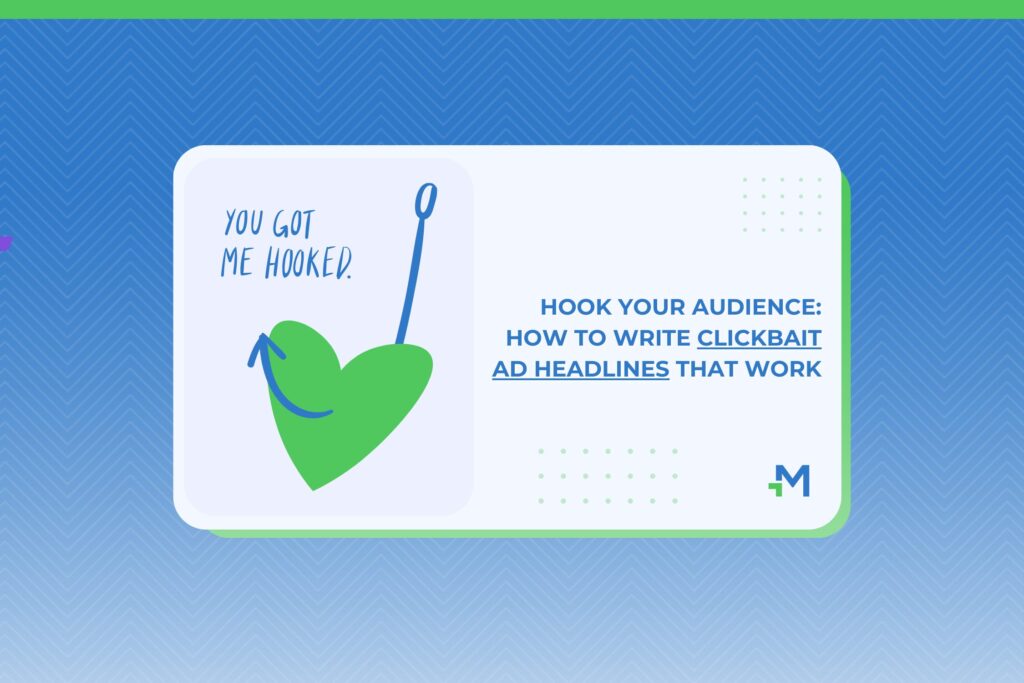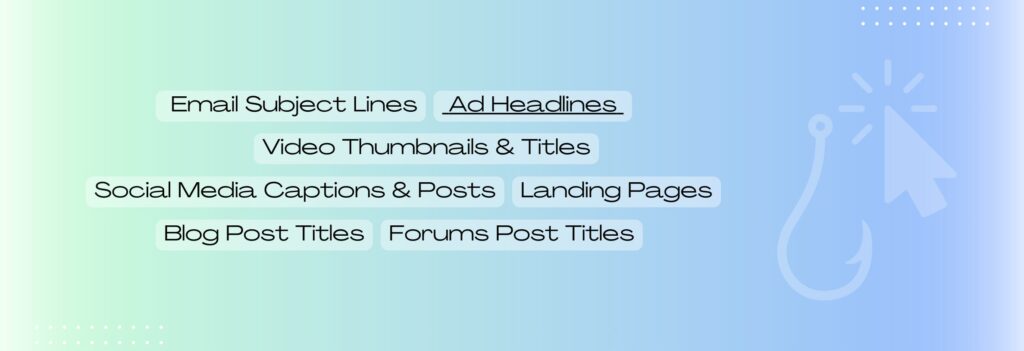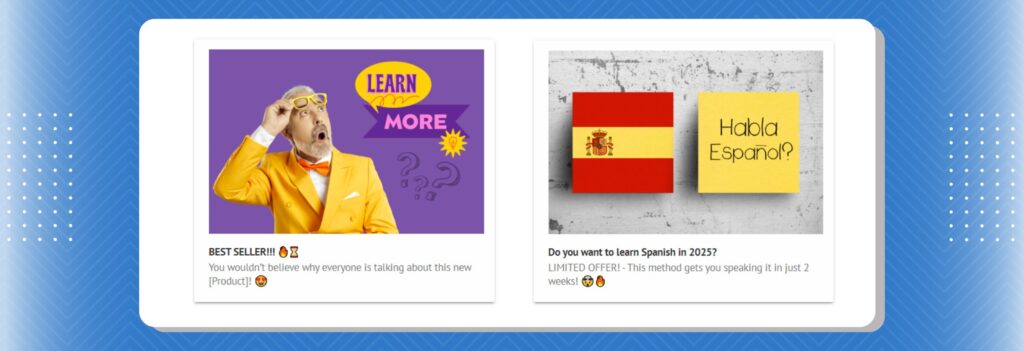Clickbait headers get a bad rap, but when used correctly, they can significantly improve your ad performance. A well-crafted clickbait ad headline grabs attention, sparks curiosity, and encourages users to engage with your ad, leading to higher click-through rates (CTR).
However, the key to success is balancing intrigue with relevance and authenticity.
In this guide, we’ll show advertisers how to create compelling ad creatives and landing pages with clickbait-style ad headlines that drive clicks while maintaining user trust.
Clickbait origins
Clickbait refers to content designed to attract attention and encourage people to click on a link, often by using sensationalized or misleading headlines.
The goal is to drive traffic to a website, often for monetary gain through ads or increased engagement.
While the content may sometimes be relevant or interesting, the headline is usually exaggerated or only loosely related to the actual article.
The term “clickbait” became widely used in the early 2000s, coinciding with the rise of digital media and online advertising. As websites began relying heavily on clicks to generate ad revenue, the practice of using sensational headlines to maximize traffic became more prevalent.
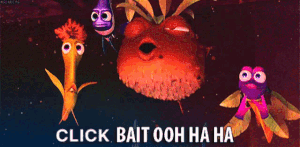
Clickbait has evolved alongside the rise of social media and algorithm-driven content platforms like Facebook, YouTube, and Twitter. These platforms prioritize engagement (likes, shares, comments) to rank content in users’ feeds, leading to an increased incentive for creators to craft more provocative headlines. In the last decade, the term “clickbait” has also become a bit of a buzzword, sometimes used to criticize content that is seen as manipulative or shallow.
However, as users became more discerning, many platforms started adjusting their algorithms to reduce the spread of misleading clickbait content, focusing instead on content quality and relevance. Despite these changes, clickbait still remains widespread, but now often comes in subtler forms, such as curiosity-driven titles (“You won’t believe what happened next…”) or emotional appeals.
In summary, clickbait has evolved from overtly misleading headlines to more sophisticated and nuanced tactics, adapting to the ways people consume content online today.
Common clickbait headlines usage
Naturally, clickbait is commonly used in digital marketing, social media, and content platforms to capture attention and drive engagement by creating curiosity, urgency, or emotional appeal.
News Websites and Blogs: Many online news outlets and personal blogs use clickbait to attract readers. These sites rely heavily on traffic to generate ad revenue, so they often employ sensational or exaggerated headlines to drive clicks, especially on viral news topics or trending issues.
Social Media Platforms: Clickbait is particularly prevalent on platforms like Facebook, Twitter, Instagram, and TikTok. With the rise of engagement-based algorithms, posts that generate more interactions are more likely to appear in users’ feeds. As a result, creators may use provocative or curiosity-driven headlines and images to encourage likes, shares, and comments.
YouTube: Video titles and thumbnails are often designed to lure viewers in, especially when creators want to maximize views for monetization. Thumbnails with exaggerated facial expressions or sensational titles like “You won’t believe what happens next!” are common examples of clickbait on YouTube.
Entertainment Websites: Entertainment news websites often use clickbait headlines to attract visitors with stories about celebrities, TV shows, movies, or viral videos. These sites often focus on gossip or exaggerated claims to drive clicks.
Online Ads and Sponsored Content: In the world of digital advertising, clickbait is often used in banner ads or promoted posts. Advertisers design attention-grabbing headlines to get users to click on their ads, whether for product promotions, affiliate links, or website traffic.
Email Newsletters: Many marketers and publishers use clickbait techniques in subject lines to get higher open rates for their emails. These subject lines often promise something intriguing or surprising, encouraging recipients to open the email to find out more.
While clickbait can be effective in gaining attention, its overuse or manipulation can sometimes backfire, leading to user frustration or decreased trust in the content. Some platforms (like Facebook) have tried to adjust their algorithms to reduce the visibility of overly sensationalized content.
The Psychology Behind Clickbait Headlines
Clickbait ad headlines work because they tap into certain psychological triggers that compel people to click. The effectiveness of these headlines is often tied to the emotional response they evoke and the way they manipulate curiosity.
Leverage Curiosity with Partial Information
One of the most common psychological triggers used in clickbait is the “curiosity gap.” This refers to the feeling of wanting to know more when a headline teases information without giving it all away. The brain craves closure and seeks to fill in the gaps of missing information, making people more likely to click on a headline to find out the rest.
✅ “You Won’t Believe What Happens When You [Do This]!”
Keep it vague but enticing, hinting at a big revelation or result.
Emotional Appeal:
Clickbait headlines often elicit strong emotional reactions, such as surprise, anger, awe, or excitement. Emotions play a significant role in decision-making, and headlines that invoke curiosity or emotion compel readers to engage.
✅ “This Simple Hack Will Skyrocket Your ROAS!”
✅ “Advertisers Are Losing Millions—Don’t Be One of Them!”
✅ “A Rookie Advertiser Made This Mistake – Don’t Be Like Them!”
Use words that stir emotion, such as “shocking,” “unbelievable,” “heartbreaking,” or “life-changing.”
Emotional headlines can be effective without being misleading. Instead of using exaggerated language, tap into genuine emotions that align with your audience’s goals.
FOMO (Fear of Missing Out):
The fear of missing out is another powerful driver behind clickbait headlines. Make readers feel like they’ll miss something important if they don’t click, or that everyone else is already in the know. Convey a time limit or need to act quickly to heighten the urgency of the situation.
✅ “Why Everyone is Talking About This New [Product/Trend]”
✅ “Don’t Miss Out on This One-Time Offer”
✅ “Why 90% of Marketers Are Ditching THIS Ad Strategy!”
✅ “Act Fast! These Strategies Are Changing the Industry!”
Use phrases like “don’t miss out,” “limited time,” or “everyone is talking about.”
Promise a Quick and Easy Solution
Offer something simple, fast, or instant, like a hack or secret that can be immediately useful or transformative.
✅ “10-Minute Routine to Lose Belly Fat Fast!”
✅ “How to Make $500 in One Hour Without Leaving Your House!”
Use time-sensitive language like “quick,” “easy,” or “hack.”
Social Proof, Trends, Exclusivity:
Clickbait headlines often tap into what’s trending or viral, leveraging social proof.
✅ “Everyone is talking about this”
✅ “Insider Secrets: What the Top Affiliates Don’t Want You to Know!”
✅ “The most viral video you’ll see today”
Use Numbers and Lists
People love numbered lists because they provide structure and imply clear, digestible information.
✅ “7 Ad Strategies That Boost Conversions Instantly”
✅ “5 Shocking Ways to Reduce Your CPC Today”
Keep the number realistic (not too high or too low) and aligned with what the content can actually provide. Use data-driven headlines or call-to-action statements based on what’s proven to work for your audience. This can enhance the relevance and effectiveness of your ads without resorting to clickbait tactics.
Exaggeration and Sensationalism:
Sensationalized headlines tend to exaggerate or promise dramatic outcomes. These headlines often imply that the content will reveal something shocking, surprising, or extraordinary, which makes readers feel like they might be missing out on something significant.
✅ “What Happens Next Will Shock You!”
✅ “He Did THIS and Changed Everything.”
✅ “The Dark Side of Affiliate Marketing No One Talks About!”
✅ “Is This the End of Traditional Advertising?”
Make sure the content can back up the bold claim. You don’t want to disappoint users, as it can damage credibility.
Ask a Provocative Question
People naturally want to find answers. Use open-ended questions that encourage curiosity.
✅ “Are You Making These Costly Advertising Mistakes?”
✅ “Why Are Top Affiliates Switching to This Ad Network?”
Simplicity and Brevity:
Clickbait headlines are usually simple, short, and easy to read. They are often optimized for scanning and mobile devices, which makes them more shareable and easier for users to process quickly. This simplicity makes them effective, especially in fast-paced environments like social media.
Use Intriguing Visuals
Your ad copy should come in pairs with visuals that match the message.
✅ A picture of a person with an exaggerated facial expression
✅ A mysterious object
Use imagery like arrows, big text, and facial expressions to emphasize key aspects.
Use Strong, Actionable Words
Start your headline with powerful verbs or action-oriented words to encourage clicks.
✅ “Unlock the Secret to [Desired Outcome]”
✅ “Master [Skill] in Just 7 Days”
Use action words like “discover,” “unlock,” “reveal,” “transform,” or “dominate” to make it sound more actionable and enticing.
Avoiding Clickbait Pitfalls
While clickbait-style headlines can boost CTRs, misleading users will backfire. Avoid these common mistakes:
Overpromising & Under-Delivering:
Make sure your landing page delivers the value your ad promises.
Using Deceptive Claims:
If your offer sounds too good to be true, users will feel misled and bounce.
Overusing Sensational Language:
Clickbait fatigue is real—use engaging but credible headlines.
When You Don’t Use Clickbait Ad Headlines
Building Trust with Your Audience
Consistently using clickbait can erode trust with your audience. When a headline promises one thing but the content doesn’t deliver, users can feel misled or deceived. Over time, this can lead to a loss of credibility and a decline in engagement.
Avoiding High Bounce Rates
If users click on a headline expecting one thing but find something completely different, they are likely to leave immediately. This results in high bounce rates, which can hurt your website’s SEO rankings and overall performance.
Compliance with Advertising Standards
Many platforms, such as Google Ads and Facebook, have strict advertising policies that prohibit misleading or deceptive content. Using clickbait can lead to ads being disapproved or even account suspension.
Sustainable Growth
While clickbait can generate temporary spikes in traffic, it’s not a sustainable growth strategy. Over-reliance on clickbait can lead to diminished returns and engagement over time as users become more discerning and skeptical.
To click or not to click?
Mastering the art of clickbait in advertising isn’t about tricking your audience — it’s about grabbing their attention and delivering on your promise.
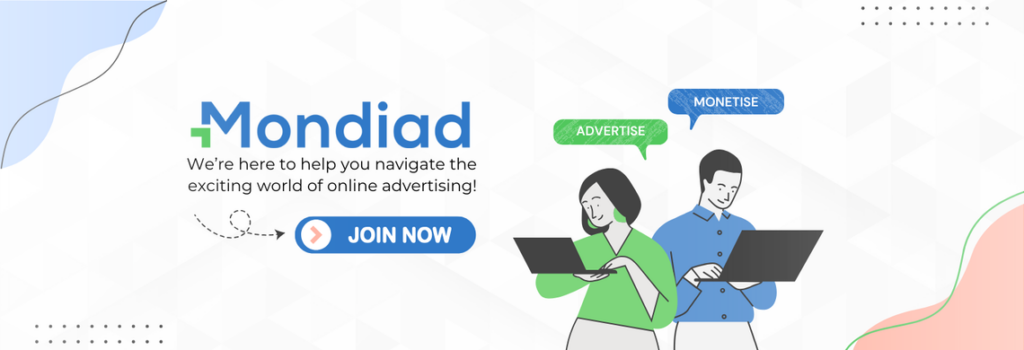 The difference between a good ad and a great one often starts with the headline. Small tweaks can lead to big results — and now, you’re equipped with the knowledge to make it happen.
The difference between a good ad and a great one often starts with the headline. Small tweaks can lead to big results — and now, you’re equipped with the knowledge to make it happen.
Try these strategies in your next campaign and watch your CTRs climb!
Your next high-performing ad is just a headline away.
